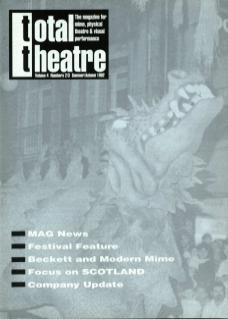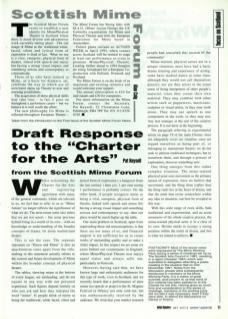Whilst welcoming the Charter for the Arts and registering agreement with many of the general comments, which are relevant to us, we feel that to refer to us as ‘Mime Artists’ no longer reflects the significance of what we do. The term mime artist also infers that we are not actors – but some precious hybrid living in a world of its own – with no knowledge or understanding of the broader concepts of drama, let alone mainstream theatre.
This is not the case. The separate statement on ‘Dance and Mime’ is also an anachronism since, apart from the title, nothing in this statement actually relates to the current and future development of Mime within the broader concept of physical theatre.
The tables, showing mime at the bottom of every league, are misleading, and do not equate in any way with our personal experience. Such figures depend entirely on who you ask and how they interpret the word ‘mime’. If people think of mime as being the traditional, white-faced, silent and lyrical form of expression (a hangover from the last century) then yes, 1 percent seeing 1 performance is probably correct. On the other hand, if people recognise mime as being a vital, energetic, physical form of theatre, linked with speech and music but having a strong visual impact and something serious and contemporary to say, then our place would be much higher up the table.
Our main problem in Scotland, apart from superseding these old misconceptions, is that there are not many of us, and financial support is not sufficient for us to create works of outstanding quality and so make a wider impact. In this respect we are some six years behind our counterparts in England, where Mime / Physical Theatre now enjoys equal status and always sells out, particularly in festivals.
However, having said that, we have known large and enthusiastic audiences for this type of work, even in Scotland, and we recently heard that a performance of pure mime (no speech or props) in the St. Magnus Festival in Orkney not only sold-out, but was enthusiastically received by the audience. We wish that your market research people had consulted this section of the community!
Mime-trained, physical actors are in a unique situation. Most have had a basic drama training and experience of acting – some have studied dance at some time, although they would not call themselves dancers; nor are they actors in the usual sense of being interpreters of other people's material, since they create their own material. They may combine with other artists such as puppeteers, musicians, sculptors or visual artists, or they may work alone. They may use speech as one component in the work, or they may not. Any text emerges at the end of the creative process. It is not there at the beginning.
The paragraph referring to experimental artists on page 19 of the main Charter, does not adequately cover our situation, since we regard ourselves as being part of, or belonging to mainstream theatre; we do not seek to jettison traditional techniques, but to transform them, and through a process of exploration, discover something new.
One thing emerges from this rather complex situation. The mime-trained physical actor uses movement as the primary means of expression, since we believe that movement, and the thing done (rather than the thing said) lies at the heart of drama, and that the truth that exists somewhere within any idea or situation, can best be revealed in this way.
With this wide range of extra skills, both traditional and experimental, and an acute awareness of the whole creative process, the mime-trained physical actor is in a class of its own. He/she needs to occupy a strong position within the remit of drama, and this is what we intend to achieve.
POSTSCRIPT: Most of the above views were expressed by The Mime Working Party during a series of meetings set up by The Scottish Arts Council in 1991, resulting in a report (October 1991) which was submitted to delegates attending a public meeting in the Queens Hall on 2 November 1991. Notes from the discussion groups were subsequently distributed to members of the Mime Working Party. It is a matter of great surprise, and concern to us that none of this material has been passed on to the Charter for the Arts. Having given so much time and consideration to this series of meetings, members of the working party did not feel it was necessary, even if they were able to attend the discussions on Dance or Drama.

